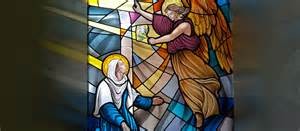Feast of the Annunciation of Our Lord
The Lord be with you
Tomorrow is March 25. It is also Good Friday, which our churches will be celebrating. However March 25 is also the Feast of the Annunciation of Our Lord.
Since ancient times March 25 has been set aside to remember the Annunciation of Our Lord. The Annunciation is when the Angel Gabriel visited the Virgin Mary announ cing to her that she would be the mother of the Son of God. Mary believed the angel and conceived our Lord; therefore Martin Luther once said that Mary conceived our Lord “through her ear.”
cing to her that she would be the mother of the Son of God. Mary believed the angel and conceived our Lord; therefore Martin Luther once said that Mary conceived our Lord “through her ear.”
In the world, at that time, people’s birthdays were not generally recognized or remembered. However, recognizing that the most important things people generally do fall closer to the day of their death than to the day of their birth, death dates were generally considered more important and remembered. Nonetheless, there was a desire to see life as having some sort of balance, as having some sort of symmetry. So it was generally believed that people, especially important people, died on the day they were conceived. (This idea was easier to embrace if no one knew when this or that person’s birthday was.) Because it was thought that Jesus died on March 25, it was held that he was conceived on March 25. That is how this date was selected for this festival. It is also how Christmas came to be December 25, for that date is nine months after March 25.
In catechism class, as we study the Apostles’ Creed, we learn that the conception of Jesus marks the first step of our Lord’s humiliation. This is the moment he took on human flesh for “us men and for our salvation.” Therefore, it marks the beginning of the New Age. The old has passed away, the new has come. Much of Christian Europe, from the 6th century and into the 18th century, recognized this by celebrating the Annunciation of our Lord as the beginning of the New Year.
It was also generally believed in Medieval Europe that March 25th was the date the Lord began his work of creating the world. Therefore, the day joined together both the first creation and the new creation in Christ.
Another sub-theme for this festival is the Holy Trinity. Of course, this Biblical teaching has its own day, the first Sunday after Pentecost, but the activity of the Triune God is clearly present in this festival as well. In the readings assigned for the day, Jesus is called the Son of God and Holy. The Father is referred to as “the Most High.” Therefore both the Son and the Father are referred to. Mary will conceive Jesus when “the Holy Spirit” comes upon her and overshadows her. The same Spirit who hovered over the waters and brought forth creation (Genesis 1:2) will now “hover over” the waters of Mary’s womb to conceive the creation’s Redeemer.
With this day, then, the Christian tradition provides us a celebration that joins the great teachings of the Trinity, Creation, Incarnation, and Redemption.
In spite of the richness of this festival, it is really about Jesus, about the incarnation, about God becoming human. Mary, and her remarkable faith, is but one feature in the story. Her status as most favored, chosen to be the birth-giver of God, are surpassed by the splendor of that event of which she was the chosen vessel, the entrance of God into the world. This is not to downplay Mary. She has her own day, August 15. But the Annunciation of Our Lord is a festival centered on Jesus. Liturgically, then, the color is white. If March 25 falls with in Holy Week (Palm Sunday through Easter Sunday), it is transferred to after Easter week. That means that this year the Feast is celebrated on Monday, April 4.
Prayer: Pour Your grace into our hearts, O Lord, that we who have known the incarnation of Your Son Jesus Christ, announced by an angel, may by his cross and passion be brought to the glory of His resurrection; who lives and reigns with You, in the unity of the Holy Spirit, one God, now and forever. Amen.
Other appropriate prayers include:
• For purity of heart
• For obedience to the word of God
• For joyful submission to the will of God
Blessings in Christ,
Pastor John Rickert
